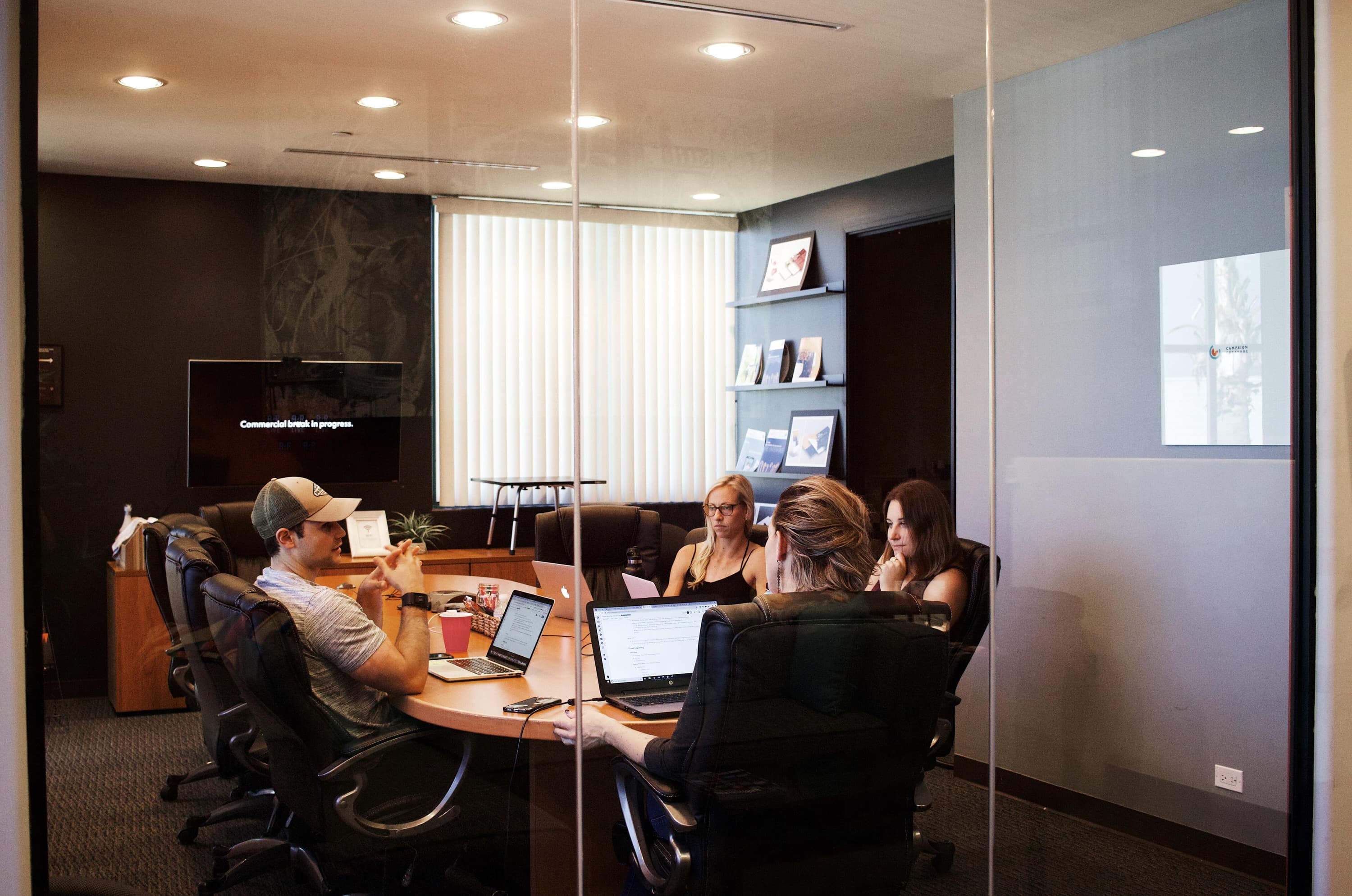How To Design a Collaborative and Effective Hybrid Workplace



Is the hybrid workplace the “new normal”? If so, how can companies design a collaborative and effective hybrid workplace despite its inherent challenges?
There’s no escaping the truth: The world’s workforce has changed. COVID-19 upended the status quo and hurled companies forward into a world of remote working and digital transformation. Now, companies are asking themselves how to forge the best path forward.
After working from home during the pandemic, 70% of employees want remote work options and flexibility to continue. Additionally, 1 in 3 employees says they’ll leave their jobs if the opportunity to work from home doesn’t continue.
Employee desires paired with promising productivity stats have prompted some businesses to stay remote. However, many companies are opting for something different: a hybrid workplace model.
Solving the Hybrid Workplace Conundrum
A hybrid model allows a company to have both in-person and remote employees to fit the desires of the employees and the needs of the company. At face value, it seems like the perfect solution. However, the hybrid workplace isn’t without its challenges.
Having team members in separate locations can make collaboration stilted. It can leave employees feeling left out and lead to unintended consequences, like unequal treatment, communication gaps, asynchronous workflows and more.
However, with the right forethought, it’s absolutely possible to create an effective hybrid workplace model that works for everyone.
7 Methods for Designing a Collaborative and Effective Hybrid Model

1. Focus on Creating an Equitable Environment
Fairness is a critical component of a hybrid workplace. Fairness and equality aren’t usually the first things that come to mind when thinking about hybrid workplaces, but it’s one of the most substantial hurdles.
Companies have to focus on creating equitable options for collaboration and communication.
For instance, consider a meeting with a hybrid team, where the in-person people are together in a room and the virtual team members join via Zoom.
In this scenario, the in-person employees would have a much easier time hearing, having their voice heard and contributing. In contrast, a remote worker joining via Zoom might struggle with connection issues or not being heard over the in-person chatter.
Organizations can overcome this particular gap by having the in-person team do meetings via Zoom like the virtual team. However, equitability isn’t just about fair meetings. It extends to workspaces, equipment and more.
In fact, 42% of remote employees don’t have adequate essential office supplies, and 10% lack reliable internet connections. To thrive in a hybrid environment, organizations must understand these issues and find ways to ensure that all of their employees have the supplies and solutions they need to succeed.
2. Adopt a Digital-First Mindset
Along the same lines, there must be intentionality behind how companies build everyone into the working experience. Companies shouldn’t look at their team as two separate groups of people and treat them that way. Instead, they need to focus on ways to get everyone on the same page.
To do this, companies should adopt a digital-first mindset, because not everyone can be physically in the office. Rather than focusing on the in-office experience, companies should pivot to focus on creating a digital company. The location of workers shouldn’t dictate the quality or the method of work. In many ways, it’s about making the working location a null issue.
Digital really speaks to how everyone will work together, whereas “remote” and “in-office” are simply denotations of location — frivolous labels in a high-functioning, digital-first hybrid workplace.
3. Lean on IT and Available Tech Resources

When the COVID-19 pandemic hit, everyone had to adjust quickly. Businesses created solutions together to make do. However, in a digital-first, hybrid environment, good enough isn’t enough. Employees are drowning in convoluted and ineffectual technologies.
- 54% of employees are overwhelmed by the sheer number of technologies they have to use.
- In addition, 61% of employees surveyed say they aren’t satisfied with their company’s technologies because they’re unreliable and buggy.
- These aggravations have led to 55% of remote employees feeling disconnected in their all-virtual environment.
The answer isn’t to run back to the office. Instead, companies should lean on emerging tech and their IT departments to create a positive and seamless experience for their employees. Technology is the only way to bridge the gap between digital and in-house workers, but lousy tech isn’t going to work in this new environment.
Organizations should leverage their existing IT departments and view them more like strategic partners for navigating this new digital normal.
4. Establish Opportunities for Spontaneous Connection
In an office setting, it’s easy for employees to interact with each other spontaneously. It’s simple to create space for team lunches and collaboration when people are face-to-face. These touchpoints are often serendipitous and unforced.
It’s harder to do online, especially since remote working tends to lead to more asynchronous workflows. However, in the digital world, most communication is very intentional and planned.
As a result, it takes a thoughtful approach to establish the same sort of opportunity for spontaneous connection in a hybrid or completely remote scenario. Companies should consider solutions like consistent messaging on a Slack channel, or Sidekick, which allows a continual video stream with employees where they can engage when they want or turn off the sound and disengage when they need to.
5. Rethink the Physical Office Design
66% of businesses are considering renovating their physical workspace to better accommodate hybrid work environments.
For many, it’s about redesigning physical workspaces to be collaborative. Rather than separate cubicles and isolated offices, the modern workspace is an open concept that is built for meaningful interactions. There are generally quiet spaces for solo work, but the primary goal is collaboration.
Others are considering office hoteling, which gets rid of permanent seating and allows employees to reserve conference rooms and workspaces when they need them. This concept works well for hybrid models because it will enable digital team members to participate when they want. It’s like saying, “You don’t have to be physically here, but you’re still a part of the team, so come in when you’d like to come in.”
6. Prioritize Employee Experience Above All Else

There aren’t any solid rules to running a successful hybrid workplace. This is virtually uncharted territory for most companies, especially in Western countries. As a result, most organizations will need to be flexible, adaptable and willing to work through the inexorable growing pains.
However, the best thing any organization considering a hybrid workplace model can do is to prioritize their employees’ experience and happiness. Whether the employees are in-person or virtual, companies should put their peoples’ well-being and engagement at the forefront.
Employee surveys, continual communication and transparency are critical components to navigating the transition to a hybrid workplace. Companies need to be sure to think about their employees with every decision and each new piece of tech.
If companies consider how the environment and inherent disparities can impact their team and work to fill in those gaps, they’ll be set up for long-term success and happy employees.
7. Offer Customized Lifestyle Benefits to Meet the Diverse Needs
In a hybrid workplace, employees will often face different challenges and needs. For example, a remote employee might need childcare to keep pace with the in-house team. In comparison, an in-person employee might need transportation to make it to the office.
The more diverse a team is, the more diverse their needs. To ensure all employees have their needs met, companies have to consider robust and diverse benefits solutions. One size cannot fit all. The need for diverse benefits is evident in every working environment, but it can become magnified in a hybrid workplace.
A solution like Fringe’s customizable lifestyle benefits platform is an excellent way for dynamic companies to accommodate the diverse needs of hybrid teams. With over 100 different benefits to choose from, employees can choose the benefits that fit their unique needs.
It’s a terrific way to make sure all employees feel appreciated, no matter where they’re working.
Contact us today to schedule a free demo!
